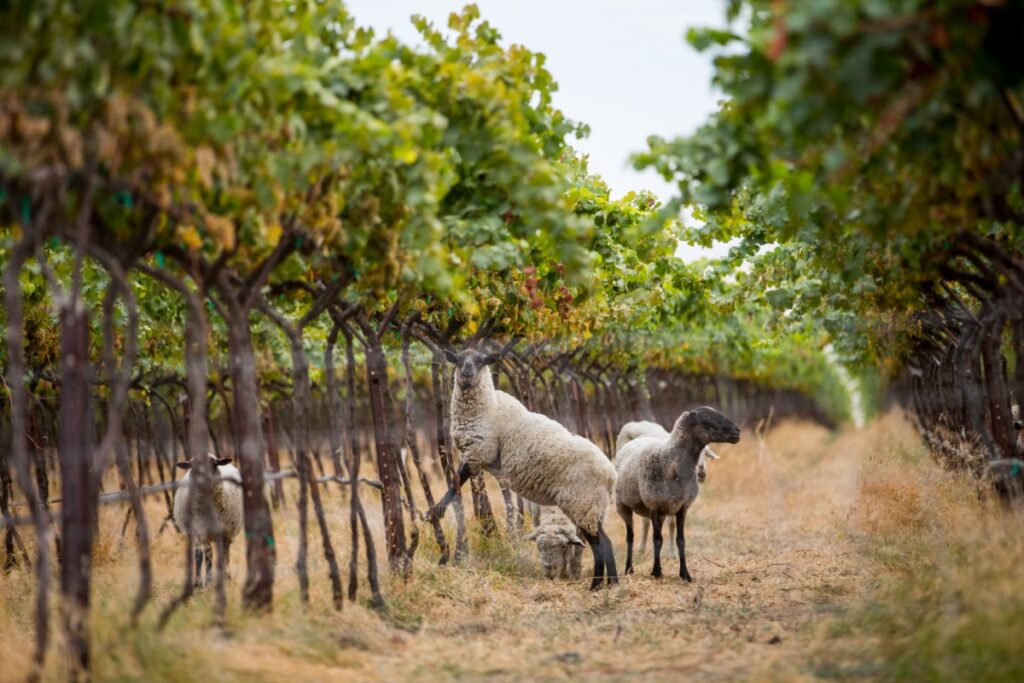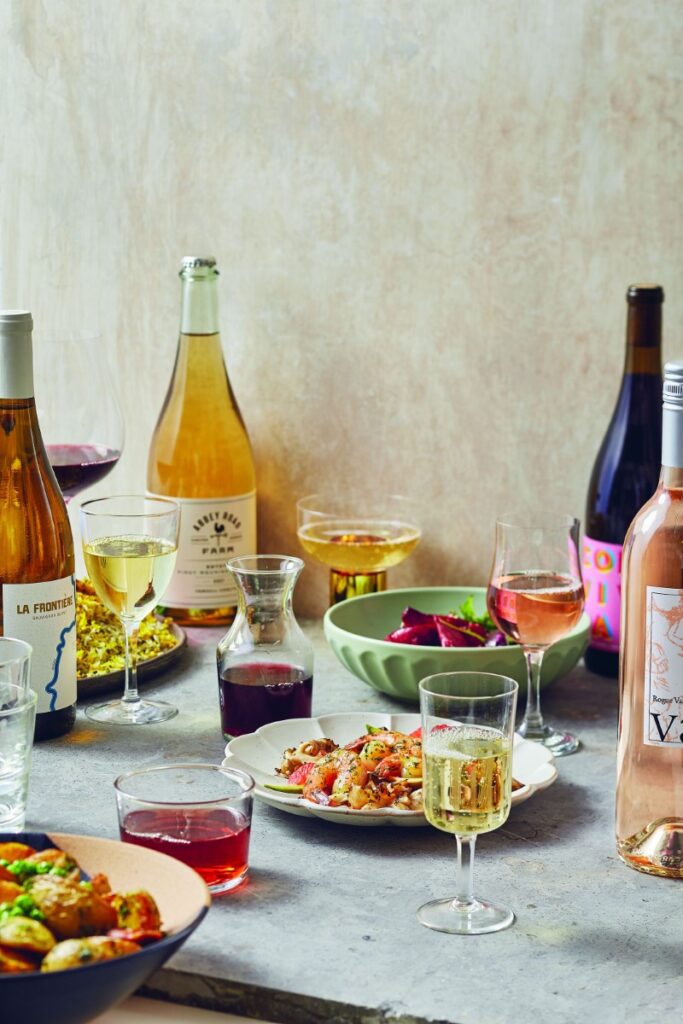More than fifty years ago, an eclectic crew brought their big dreams to an offbeat state. In a region mostly known for its vast forests, volcanic peaks, verdant valleys, and rain — so much rain — they wanted to plant grape vines. Despite a choir of skeptics from more established wine regions, this fearless collective of academics, scientists, cowboys, and artists stayed true to their vision. Now their stories are told around the table, renegade winemakers charting history.

Back then, winemaking in Oregon took a relentless spirit, a drive to experiment, invent, and adapt with no guide or map or manual for growing grapes here on the razor’s edge. It took faith, hoping each year that the grapes would ripen, because there was no guarantee. And it took grit, a willingness to push past the failures and learn from the mistakes. But the payoff? Wines with ethereal beauty and an extraordinary expression of place. A place that, quite frankly, was very much off the radar.
An often-told tale recounts those early years, when the wine pioneers would haul their best bottles to international competitions or national tastings, and inevitably had to point to where Oregon was on the map. Today, wine connoisseurs point to that same spot on the map as a top wine destination they want to visit.
Oregon, it turns out, is climatically one of the best places to grow grapes on the planet. According to Dr. Greg Jones, one of the leading climatologists in wine, Oregon’s northern latitude and geographic surroundings provide for ideal growing season lengths, low risk from weather extremes, and some of the largest diurnal temperature ranges during ripening of anywhere in the world. What does this mean? During the peak ripening period (generally May through September), the days are long and warm, allowing the grapes to develop beautiful and concentrated flavours. At night, the extreme drop in temperature slows down the maturation, helping to preserve the natural acidity. This leads to the balanced and food-friendly wines that Oregon is so revered for. Add in ancient geological drama, including volcanic eruptions and the epic Missoula floods, and Oregon also has a magnificent and varied terroir that is found in pockets across the state from the Willamette Valley to the Rogue Valley.
The geography, the climate, the soil — and of course, that dogged spirit — are a few of the many reasons Oregon wine is synonymous with quality today, and why labels consistently earn top scores in every major wine publication. But despite the accolades and growth, a defining ethos perseveres that keeps Oregon wine distinctive. It’s still a little maverick, it still draws outside the lines, and, well, there’s still all that damn rain.
That’s why upstart winemakers still flock here. They seek out that unpredictability. They embrace the unknown of a region still on the rise. What prevailed then remains true today — wine in Oregon is emotion. Whether you uncork a bottle of Pinot Noir or Picpoul, that wine represents a risk-taking spirit. It’s pushing boundaries, it’s the pursuit of quality, and it’s innovating with purpose.
When you talk to winemakers here, they want to move people with their wine. They want to connect you to the spirit of this place. They want to capture the purest expression of the soil, the seasons, the sense of wonder found in something shaped by nature.
This deep connection to the environment defined the industry from the beginning and the state has long been a leader in environmental stewardship. Early on, the industry adopted sustainability as a core tenet, seeking out third-party certifications with the highest standards such as Demeter Certified Biodynamic, USDA Certified Organic, and Salmon-Safe. In fact, Oregon is home to some of the largest biodynamic vineyards in the country (King Estate and Montinore) and has the largest percentage of certified vineyards nationally.
That is why you can spot sheep munching weeds in vineyards, nest boxes for songbirds as a form of natural pest management, and beehives for pollination. A commitment to building biodiversity in the vineyard and regenerative agriculture has also taken root. Most recently, Oregon had the second winery in the world to achieve the Regenerative Organic certification (Troon Vineyard) and is one of the only states in the U.S. with a bee-friendly wine trail.
Ask any Oregon winemaker, from the pioneer to the upstart, what they think sets the state’s wine industry apart and one word always rises to the top: collaboration. You can see it during harvest when winemakers are working around the clock. Here’s a common scenario: It’s dark outside and probably raining and the neighbouring winery has a tractor break down. No problem, another winery will lend you one and bring a batch of cookies, too.
Or it’s 6 AM and a few vineyard sheep have escaped the fence — yes, it’s raining sideways — and the first truck that encounters the sheep is a neighbour and a winemaker on the way to work. They park, and begin to corral the sheep, texting an update. But the vineyard manager already had a call about his wayward sheep and when he meets up with his colleague, he gives him an espresso. That’s collaborative spirit. And that’s Oregon.
You also see it in the winemaking collectives popping up across the state — a model where upstart winemakers share a facility and equipment and expertise as they grow their craft. Here, there are no secrets. Only rising tides. In this culture, innovation thrives. It’s why you find small plots of obscure varieties like Trousseau Noir and Vermentino flourishing. Or why you find a high school art teacher turned winemaker building massive handmade clay amphorae for aging wine, resurrecting an ancient tradition that’s embraced by winemakers across the state.
In Oregon, the sense of fearlessness that sparked the industry lives in the next generation in new ways, building a bridge between the past and the future. A bridge that exists between the wine and food worlds, with delicious creations. There’s Brigid’s Bender, a semi-firm cheese washed in red wine from Briar Rose Creamery in the Willamette Valley’s Dundee Hills. And the world-famous Rogue River Blue from Rogue Creamery in Southern Oregon that’s wrapped in Syrah leaves soaked in pear brandy.

Wine and food are the great connectors. That’s something you’ll read in many of the winemaker profiles in this book. It’s a big reason many of them pursued a career in wine—to connect to soil, to seasons, to friends and family, to other cultures, to humanity. For many in this book, wine is a universal language. An expression of time and place and memories best shared around the dinner table.
And that’s what this book is all about. It’s a culmination of stories from Oregon’s beautiful wine country that we hope you share around the table. The recipes focus on ingredients abundant in the Pacific Northwest — fresh seafood, seasonal vegetables, native plants, wild mushrooms — that can be enjoyed and procured by home cooks everywhere. Some recipes are personal favourites shared by the winemakers themselves, others come from a kindred group of chefs who are just as dedicated to celebrating and preserving the bounty of the region. We hope these recipes bring you to the heart of Oregon wine country, where the scent of evergreens, the sound of rain, and the sense of possibility is ever-present. Where the stargazers and game changers and eternal optimists know that with every vintage you are rolling the dice. But they do it anyway. Because when you get it right—it’s magic.

Nick’s Mint, Coriander, and Fennel Lamb Kebabs
Swedish Shrimp Salad on Rye Toast
Salad of Luscious Fruits, Creamy Burrata & Aromatic Herbs
Caramelized Fennel with Manchego, Chili & Almonds
Excerpted from Oregon Wine + Food: The Cookbook by Danielle Centoni and Kerry Newberry. Photography by John Valls. Copyright © 2023 by Danielle Centoni and Kerry Newberry. Recipes copyright © 2023 by individual restaurants. Excerpted with permission from Figure 1 Publishing. All rights reserved. No part of this excerpt may be reproduced or reprinted without permission in writing from the publisher.


